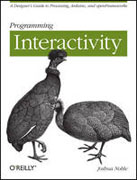
Programming interactivity: a designer's guide to processing, arduino, and openFrameworks
Noble, Joshua
There is, at present, an exploding synergy between designers and programmers;the boundaries between disciplines are blurring and the arenas into which experiments in these fields extend are expanding. This encompasses an entire range of creative people, from artists interested in hacking for art projects, to computer scientists interested in prototyping techniques for HCI projects to developer designers looking for new tools that will give them more power and newer tools and techniques. While "Programming Interactivity" is in most respects a tutorial, it's also a thought piece on one of the most vibrant areas of research and excitement in this area: the development of novel interactions for users. This book will also extend the usage of several different tool sets with different strengths and weaknesses to any interested party who may be able to contribute to the conversation that is taking place. "Programming Interactivity" is for artists and designers without computer science backgrounds who areinterested in using electronics and programming to create designs and artwork. If you want to learn how to create complex and rich interactive experiences with which viewers can truly engage, explore, and experiment, this book is theplace to start. It explains the basics of programming and electrical engineering and introduces three freely available tools created for artists and designers. Code and explanations for some of the most common topics and themes are provided that you can learn from and use in your own projects. You'll learn thefundamentals necessary to begin working with code and then move into exploring three open source frameworks created for artists and designers: Processing, Arduino, and OpenFrameworks. Each of these tools is used to explain and explore common themes in interactive art and design, from 2 and 3D graphics, sound, physical interaction, circuitry, and more. Readers are provided with in-depth discussions of design considerations, working code samples, and guides to how to explore and experiment further. The book also explores some of the most cutting edge techniques used in interaction design and provides the background and technical information needed to design, program, build, and troubleshoot your own projects. The reader of this book is assumed to be a designer or artist looking to explore interactive design using code. The three tools highlighted in this book are all created expressly for designers: Processing - An internationally acclaimed programming language and environment for artists and designers based on Java and run on the JVM; Arduino - A revolutionary and highly regarded systems that integrates a microcomputer prototyping board, IDE, and programming language; and, OpenFrameworks - A coding framework built to provide thepower of C++ with a simplified API that designers and artists can use. This book is intended for any designer or artist curious about interactive design and artwork. No assumptions are made about the reader other than that they are interested in creating interactive artworks, have access to a Macintosh, Linux,or Windows computer, and have or are willing to purchase an Arduino board. This book will be suited both for use as a textbook in a classroom at a school of art and design or technology as well as for the motivated autodidact. Most readers will read the book once, refer back to it many times as they learn moreabout the subject matte by creating works or by reading other books, and continue to refer back to the book as a touchstone when their interests or the nature of their projects change.
- ISBN: 978-0-596-15414-1
- Editorial: O'Reilly
- Encuadernacion: Rústica
- Páginas: 734
- Fecha Publicación: 01/07/2009
- Nº Volúmenes: 1
- Idioma: Inglés
